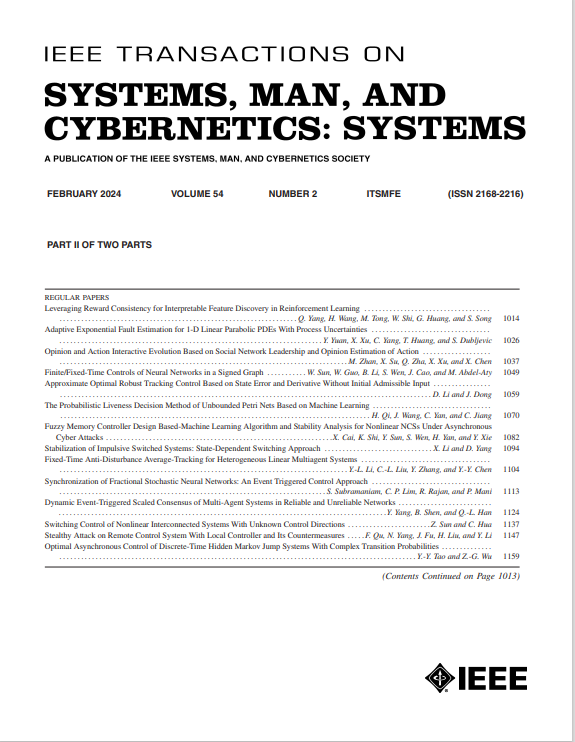基于复合学习策略的机器人多指神经自适应固定时间同步控制
IF 8.6
1区 计算机科学
Q1 AUTOMATION & CONTROL SYSTEMS
IEEE Transactions on Systems Man Cybernetics-Systems
Pub Date : 2024-12-05
DOI:10.1109/TSMC.2024.3500776
引用次数: 0
摘要
拟人化多指机器人手(MFRHs)的灵巧操作对于执行各种复杂任务至关重要,其中手指之间的协作是必不可少的。本文提出了一种新的基于神经网络的复合学习策略,用于拟人化mfrh中受未知动态和干扰的多指同步控制。利用图论,手指之间的相互联系被描绘并集成到动态方程中。采用改进的非奇异终端滑模(TSM)技术,在不触发奇异的情况下实现误差变量的定时收敛。在复合学习的框架内,通过利用在线历史数据和回归矩阵制定了一种新的可计算预测误差。采用预测误差与回归矩阵相结合的方法进行参数估计,在较温和的区间激励(IE)条件下,不需要严格的持续激励(PE)条件,就能准确估计参数。仿真实验验证了该方法的可行性和有效性。本文章由计算机程序翻译,如有差异,请以英文原文为准。
Neuroadaptive Fixed-Time Synchronous Control With Composite Learning Policy for Robotic Multifingers
Dexterous manipulation of anthropomorphic multifinger robotic hands (MFRHs) is crucial for performing diverse and intricate tasks, where collaboration among the fingers is essential. This article presents a novel neural network-based composite learning strategy tailored for the synchronous control of multiple fingers in anthropomorphic MFRHs subjected to unknown dynamics and disturbances. By leveraging graph theory, the interconnections among fingers are delineated and integrated into the dynamic equations. The modified nonsingular terminal sliding mode (TSM) technique is employed to achieve fixed-time convergence of error variables without triggering singularity. Within the framework of composite learning, a novel computable prediction error is formulated by harnessing online historical data alongside the regression matrix. The combination of prediction errors and the regression matrix is utilized for parameter estimation, which, under a milder interval excitation (IE) condition, facilitates accurate parameter estimation without the requirement for the stringent persistent excitation (PE) condition. The feasibility and effectiveness of the proposed technique are demonstrated through simulation experiments.
求助全文
通过发布文献求助,成功后即可免费获取论文全文。
去求助
来源期刊

IEEE Transactions on Systems Man Cybernetics-Systems
AUTOMATION & CONTROL SYSTEMS-COMPUTER SCIENCE, CYBERNETICS
CiteScore
18.50
自引率
11.50%
发文量
812
审稿时长
6 months
期刊介绍:
The IEEE Transactions on Systems, Man, and Cybernetics: Systems encompasses the fields of systems engineering, covering issue formulation, analysis, and modeling throughout the systems engineering lifecycle phases. It addresses decision-making, issue interpretation, systems management, processes, and various methods such as optimization, modeling, and simulation in the development and deployment of large systems.
 求助内容:
求助内容: 应助结果提醒方式:
应助结果提醒方式:


